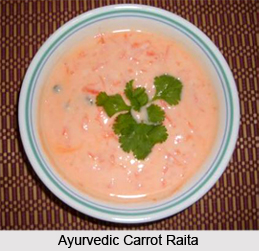 Ayurvedic carrot raita is very healthy and delicious raita. Carrot and yogurt are the main ingredients of this recipe. This raita is known to supply good vitamins. It goes very well with main course meals like parathas, rotis or even biryani. One can also have this as dipping or spread while having rolls. Ayurvedic carrot raita is very quick and easy to make and can be prepared at home.
Ayurvedic carrot raita is very healthy and delicious raita. Carrot and yogurt are the main ingredients of this recipe. This raita is known to supply good vitamins. It goes very well with main course meals like parathas, rotis or even biryani. One can also have this as dipping or spread while having rolls. Ayurvedic carrot raita is very quick and easy to make and can be prepared at home.
Ingredients of Ayurvedic Carrot Raita
•Half green chilli finely chopped
•One cup of raw carrots
•Two tablespoon of ghee
•Half teaspoon of black mustard seeds
•A pinch of hing
•Handful of cilantro leaves finely chopped
•One cup of plain yogurt
•One-fourth teaspoon of salt
•Coriander leaves
Method of Preparing Ayurvedic Carrot Raita
•To make the Ayurvedic carrot raita, wash the carrots thoroughly and grate it not very finely.
•Stir the carrots into the yogurt and mix it gently. Keep it aside.
•Heat ghee in a small saucepan and add mustard seeds, cumin seeds and then hing to it. Mix well until the seeds pop up.
•Then add the chilli and coriander leaves.
•Remove the saucepan from the fire and pour the cooked spices and the salt in the yogurt and Ayurvedic carrot raita is ready to serve.
Benefits of Ayurvedic Carrot Raita
The main ingredient of this raita which is carrot is a root vegetable and usually is red and orange in colour. It has sweet taste and is rich source of fibre, sugar and Vitamin A. The various benefits of this raita are:
*
•It helps in digestion.
•It purifies blood.
•It keeps the body cool.
•It is also helpful for the people who are trying to reduce weight.
•It helps in maintaining a healthy skin.
•It balances the acid alkaline ratio in the body.
•It also improves eyes.
Caution about Ayurvedic Carrot Raita
Carrot has pungent and heating qualities, which may provoke Pitta. Pitta and Kapha prakriti person can use it occasionally. Pregnant woman should not eat it.




















